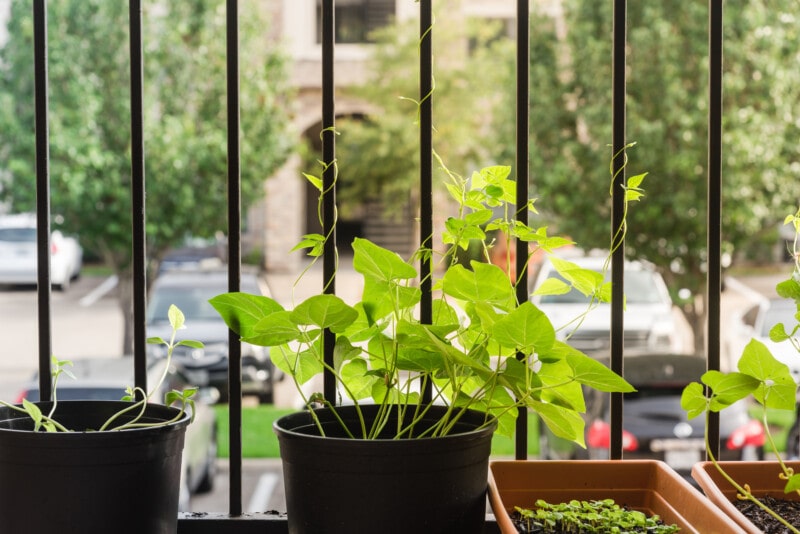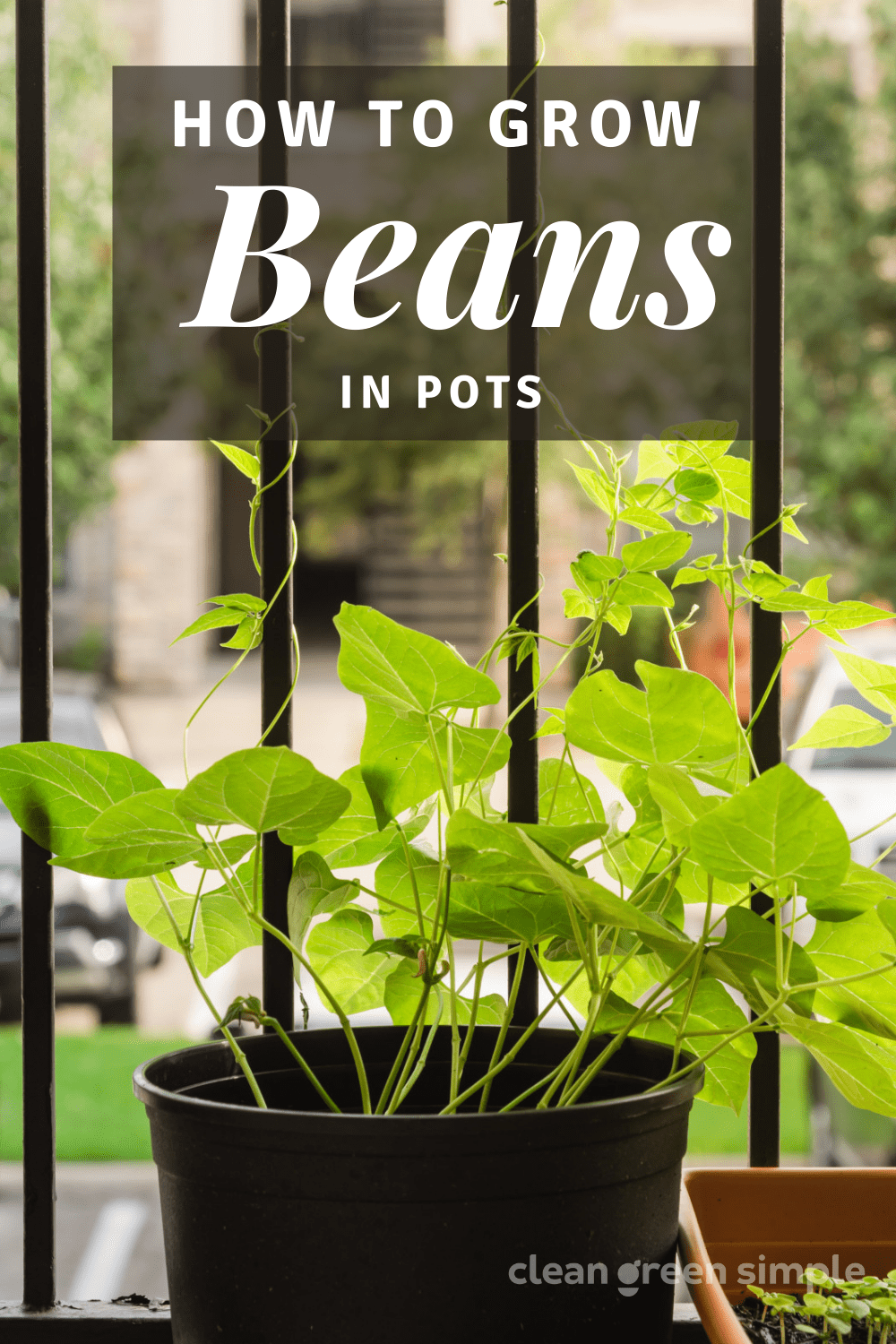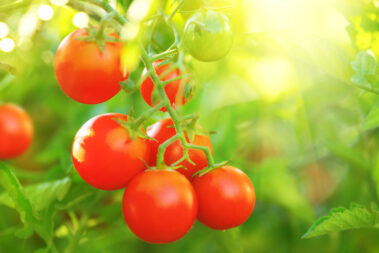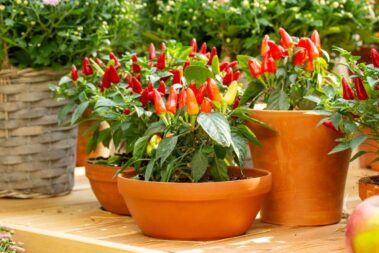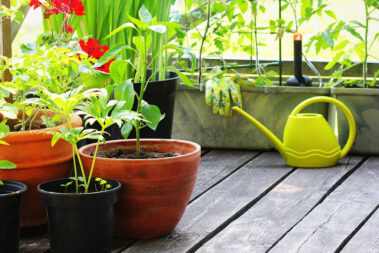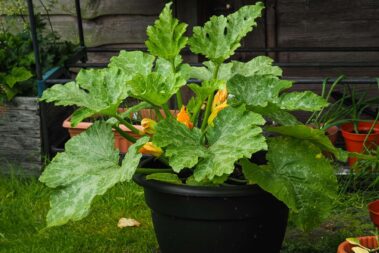Learn how to grow beans in pots and find out our seven tips to ensure a successful harvest. We’ll also look at the best types of beans to grow in containers and solutions to some common problems you may run into.
Table of Contents
What Are the Best Types of Beans to Grow in Pots?
There are two main varieties of beans: bush beans and pole beans. Most types of beans are available in either variety.
Bush Beans
Bush beans grow on strong stems and reach a maximum height of about two feet tall. They do not require trellising or support and take on a bushy shape as they mature. This variety tends to start producing in about six weeks and is usually done making beans a few weeks later.
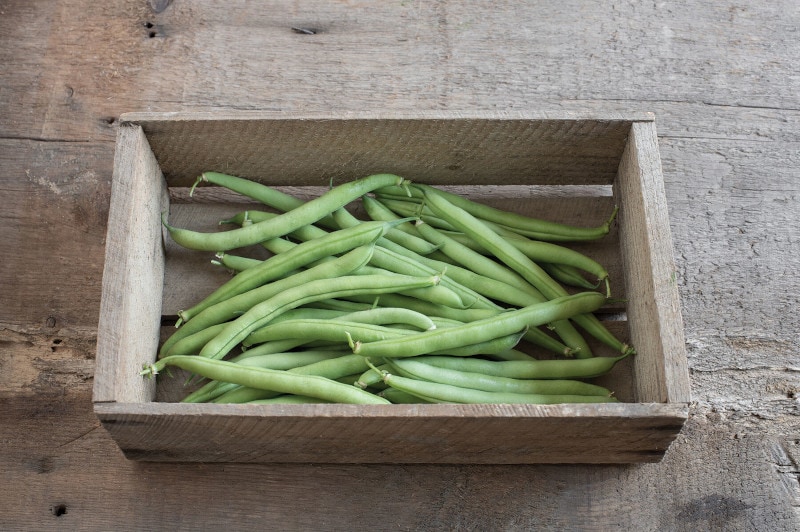
Because of their short stature and short growing season, bush beans are a great choice for use in shallow pots and for growing northern climates.
Bush beans only require about 7 inches of soil to grow. And because they aren’t vining like pole beans, they require very little maintenance. The fact that the beans mature all at once also means less time spent harvesting and caring for the plants.
Pole Beans
Pole beans, on the other hand, are vining plants that require support and something to crawl up as they mature. They take two to three months to start producing beans but keep producing throughout the season. The more often you harvest your pole beans, the bigger your total harvest will be.
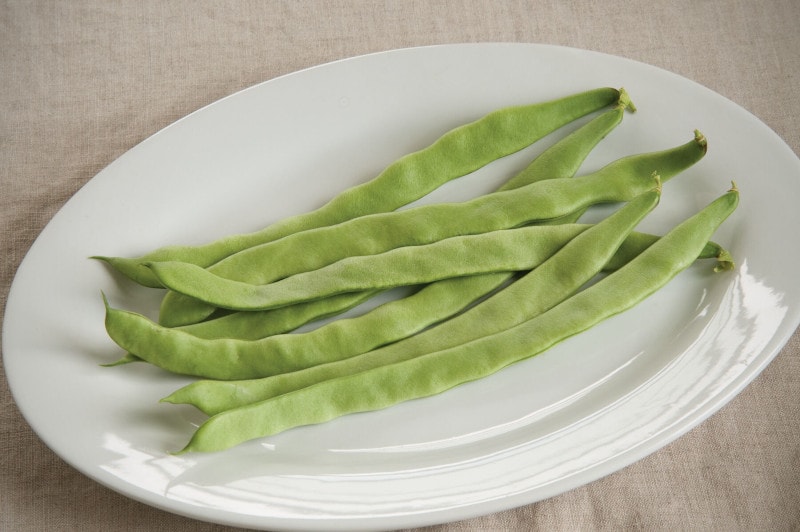
These types of beans have deeper root systems that require at least 9 inches of soil. Because they grow so tall, they also need heavier, more substantial pots and protection from the wind.
Pole beans are great for container gardeners with a little extra space to spare who have longer growing seasons and want a continual harvest throughout the summer.
Which type of bean to grow in your pots depends largely on the size of pots available, the length of your growing season, and how much continual care you are able to provide. For most gardeners, though, growing either (or both!) is an option.
7 Tips for Growing Beans In Pots
Whatever beans you choose to grow, there are a few things you can do to ensure success. Here are our seven tips to grow prolific beans in containers.
1. Pick the Perfect Location
Beans need a good amount of sun to produce well. Look for a spot that gets at least eight hours of sunlight each day. If a location this sunny is difficult to come by, look for a variety of pole bean that is more shade tolerant. These will do well with as little as six hours of sunlight each day.
Wind and heat are two other factors to consider when deciding where to place your bean container garden.
Pole beans grow tall and are easily blown over. Choosing a spot that is well-sheltered from gusts is a must.
All bean varieties need warmth to germinate. Placing pots against south-facing walls will help increase the soil temperature while the seeds germinate. Once the sprouts mature and the weather warms up, moving the pots to a slightly cooler but equally sunny spot can help avoid wilting.
2. Pick the Right Pot
Beans have shallow roots compared to many other vegetables, which means it is possible to grow them in smaller pots.
Bush beans only need pots about 6 inches deep, while pole beans need closer to 9 inches. Since pole beans grow so tall, it is important to choose a heavy, wide pot that is less likely to blow over. You can also situate pots next to deck railings and secure them to avoid them blowing around.
In larger pots—those ten inches wide and at least ten inches deep—is possible to grow more than one bean plant. Bush beans need a little more space, at least 6 inches between plants, while pole beans only need about 4 inches between plants.
Just as important as the size of the pot is the drainage. Make sure your pot has at least three drainage holes. Beans like damp soil but do not tolerate over-saturated dirt very well.
3. Prepare the Soil
Beans are not overly picky about what they grow in. Like all legumes, they fix their own nitrogen and are better able to grow in low-nutrient conditions than other plants.
Still, to maximize your harvest and make caring for your plants easier, it is a good idea to start the season with quality, fresh potting soil.
Unlike traditional garden soil, potting soil contains vermiculite or perlite. Both substances are great for retaining moisture and controlling the release of nutrients. These features are important in pots since the low soil volume is at risk for drying out and having nutrients rinsed away.
Fill your pots with a quality, organic potting soil at the beginning of the season. Once your beans have died off for the year, you can repurpose the soil in your garden beds to put all that legume-fixed nitrogen to use.
4. Sow As the Weather Warms
Beans are warm-season plants, which means they require warm soil to germinate. They are also less tolerant of cold weather and frost than other legumes such as snap peas.
When growing beans in pots, you have a couple of options in how and when to sow your bean seeds.
To extend your season—something that is important if you experience short summers—bring your pots inside to sow your seeds. Put them in a warm spot and allow the soil to warm up before planting. Once the weather has warmed up and the threat of frost has passed, move your mature seedlings outside into a warm spot.
Your other option is to wait until the average outdoor temperature is over 60 degrees. Place your pots in a warm, sunny location and direct sow the seeds into them.
Typically, bean seeds are planted one inch below the soil level, but be sure to reference the directions that come with your seed packet for specific requirements.
5. Water Consistently and Feed Monthly
Consistent watering is important for maximum yield. Check your soil daily by pushing your finger into the pot. Water once the top inch or two of soil is dry to the touch. As long as your pots drain well, you should not have to worry too much about over-watering
Once the plants begin to flower, it is especially important to keep the soil constantly moist. If the plants get too dry, they will drop flowers.
As for fertilizer, beans will do well with a monthly application of liquid or granular fertilizer. Look for a product with a lower nitrogen concentration since beans can fix their own nitrogen and since too much of this nutrient will reduce pod production.
6. Maintain Plants As Needed
Beans are fairly easy keepers and do not require a lot of attention.
If you are growing pole beans, you will have to provide a lattice or support for them to climb. They typically climb well on their own, but it is still a good idea to check on their progress and train the vines as needed.
7. Harvest When Beans Reach Full Size
Bush beans will begin producing their bounty all at once, with the harvesting period typically only lasting two weeks. Some varieties, however, may continue to produce for a month or more, especially if mature pods are picked regularly.
Pole beans will produce continuously throughout the growing season. You can encourage more prolific production by harvesting pods as soon as they have reached full size.
Most beans are ready for picking once they reach about four inches in length. However, there are many different varieties, some smaller and some larger, so make sure to reference your seed package for specific directions.
Continue harvesting regularly until the plant stops producing flowers or the weather cools. Once the first frost hits, bean plants will die. If your plants are still producing when the weather turns, you can bring them inside and place them in a sunny, south-facing window to extend the season.
If you do not have a sunny spot in the house, you may want to consider getting some quality grow lights like these from Spider Farmer.
Common Problems You Might Face
Beans, especially bush beans, are fairly tough. But there are a few pests known to feed on these legumes and some common diseases to be aware of before you start your bean container garden.
- Bean rust – This fungal infection can quickly wear on your bean plants and cause production to plummet. Look for white or yellow spots on the leaves that grow into red or brown pustules with yellow rings. Cut off affected leaves as soon as you see them. Assuring there is plenty of space and airflow between plants will reduce the odds your plants will be affected.
- Bean common mosaic virus – This legume-attacking virus causes a distinctive yellow mottled pattern on leaves and can stunt the growth of plants. Most often, this virus is already present in the infected seed but can also be transmitted by pests. Buying your seeds from a reputable dealer and setting up your container garden away from other foliage is the best way to avoid issues.
- Pests – Aphids and bean leaf beetles are the most common pests that target legumes. They cause damage to the leaves that can lead to stunted growth and a reduction in pod production. Bean beetles will even feed on the bean pods themselves. If you notice tiny yellow bugs or black and yellow beetles on your plants, wash them with soapy water to kill these pests.
FAQ
How many beans can you plant in a 5-gallon bucket?
In general, you can plant two to three bean plants in a 5-gallon pot. Bush beans have smaller root systems and can be planted closer together, so you can pot up to three of these together. Pole beans require more space, so only plant two of these per container.
Do beans need full sun?
Yes, beans do best with eight or more hours of sunlight per day. When choosing a place for your bean container garden, we suggest a south-facing area of your yard.
Can you use tomato cages for green beans?
Yes, you can use tomato cages to support your green beans and other pole beans. However, because of their shape, these will make harvesting more difficult than using a flat trellis option.
More Container-Loving Crops
Beans aren’t the only vegetables that are easy to grow in pots. Here are a few more plants to consider adding to your veggie container garden.
- Basil – This flavorful herb is perfect for growing indoors and out.
- Cherry tomatoes – These pint-sized tomatoes actually tend to grow better in pots than in the ground in many climates.
- Eggplant – This is another great nightshade to plant in containers and a beautiful addition to any patio.
- Carrots – Most people don’t consider growing root veggies in pots, but carrots actually do quite well so long as you pick the right variety.
Not satisfied yet? Here are the ten easiest vegetables to grow in pots.
Loving these simple garden tips? Be sure to sign up for our newsletter to get more content like this delivered right to your inbox.
Wrap Up
Growing beans in pots is easy so long as you have the right pot, the right spot, and the right type of bean for your setup.
Have you ever grown beans in pots? What did you struggle with or wish you had known before you started? Let us know in the comments below.
- How to Pick the Perfect Watermelon For a Sweet Summer Treat - April 10, 2024
- Future Kind’s Foundations: A Multivitamin Made for Vegans - December 5, 2023
- Does Nutritional Yeast Go Bad? - November 28, 2023

